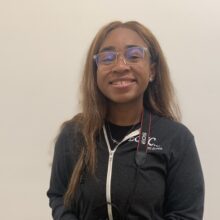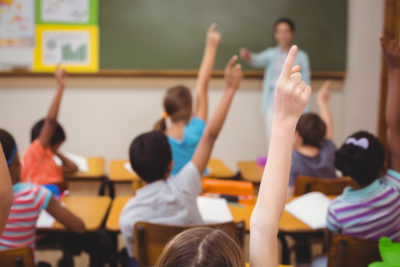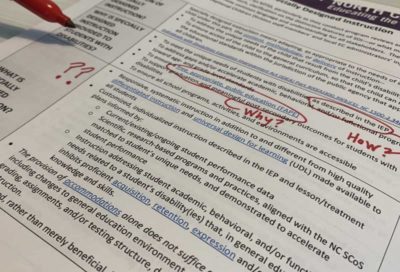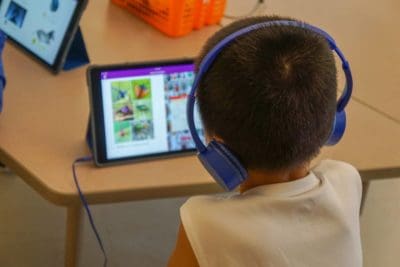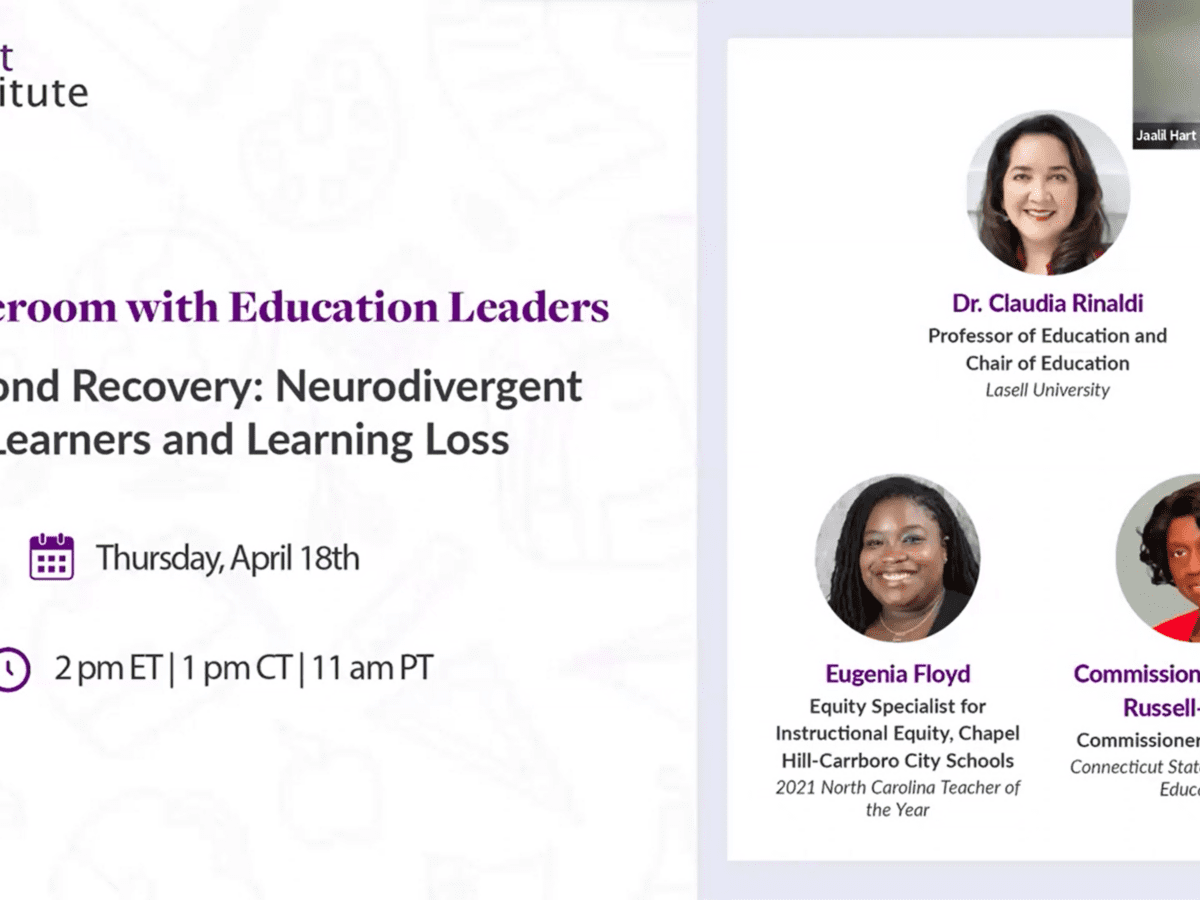
Share this story
- As North Carolina continues to work toward pandemic learning recovery, schools must do more to account for the needs of diverse students, panelists at a @Hunt_Institute webinar said.
- Panelists said that chronic absenteeism and a lack of connection at school can make post-pandemic learning recovery more difficult, especially for multilingual learners and students with disabilities.
|
|
As North Carolina continues to work toward pandemic learning recovery, schools must do more to account for the needs of diverse students, panelists said during an April 18 webinar hosted by the Hunt Institute.
Ahead of the Sept. 30 deadline to spend federal Covid relief dollars, school districts across the nation are evaluating learning recovery strategies implemented during the pandemic.
But “as of 2022, less than a third of pandemic impact analyses disaggregated data to evaluate implications for students with learning differences,” the webinar description says.
Panelists said performance gaps between students with learning differences and neurotypical students were magnified during the pandemic. Educator shortages for general and special educators and changes in learning environments have both contributed to an increased lack of access, panelists said.
The webinar discussed two groups of students: English Language Learners (ELL) and students with learning differences like autism and dyslexia.
In North Carolina, one out of five public school students speak a primary language other than English at home. In 2020, there were 114,901 multilingual learners in North Carolina public elementary and secondary schools, according to the National Center for Education Statistics (NCES).
As of 2022-2023 school year, 186,869 students were enrolled across 18 different special education programs, according to state data. In North Carolina, these students are served through Exceptional Children (EC) programs.
Lasell University Chair of Education Dr. Claudia Rinaldi spoke about her research on multi-tiered support systems for students with learning and behavioral challenges.
Rinaldi said there should be more diversity in the education profession to reflect the students that are being served.
“There is a connection that happens for students, and they need a teacher that looks like them or speaks the same language or that understands the culture, and languages in a different way,” she said. “And that connection is the beginning step to wanting students to come in and stay in school.”
The most recent report to the General Assembly on North Carolina’s learning recovery can be found here. You can watch the Hunt Institute’s webinar on their Youtube channel.
Needs of diverse learners
The Individuals with Disabilities Education Act (IDEA) mandates public school districts to provide students with disabilities with a Free Appropriate Public Education (FAPE). In order to do that, schools must create a plan for each child’s special education instruction, included in a written document known as an Individualized Education Program (IEP).
The IEP is a collaborative document between teachers, parents, and other service providers that shows how instruction will be tailored to meet a student’s needs.
Charlene Russell-Tucker, commissioner for the Connecticut State Board of Education, said federal relief funds helped districts further personalize instruction for students.
She said personalized instruction has a positive impact on neurodivergent students, but also on future teaching methods for all students.
“These students are general education students first, and so while we isolated and talked about the sort of support they needed, we also prioritized the need for this to be incorporated in the general learning recovering acceleration process that we engaged in,” Russell-Tucker said.
English learners can also qualify for special education services through the N.C. Department of Public Instruction’s (DPI) Office of Exceptional Children.
“As we are doing the recovery, I think there needs to be a lot more investment on that professional learning of how to do a collaboration,” Rinaldi said. “But using a multi-tiered system of support to use the data and really, truly bring the right stakeholders to the table to be able to plan accordingly for students who are learning English but also have a disability.”
Rinaldi said that dually identified students need ESL (English as a Second Language) to access the curriculum included in their IEP.
“I think the unique needs of students who are dually identified as having a disability and also being English learners, really became capitalized during the pandemic, mostly because we couldn’t meet all of them,” Rinaldi said. “There needs to be direct services to kids who are in the severe spectrum, but also in a mild moderate space and inclusive settings and also the whole spectrum of support.”
Increasing school attendance and welcome
The number of public school students who were chronically absent in 2023 increased nearly 11 percentage points from 2019.
Among students with learning differences, there was an increase of nearly 14 percentage points during the same time period. For English language learners, the number of chronically absent students increased by more than 15 percentage points.
Russell-Tucker said a lack of support and connection can lead to higher rates of absenteeism and suspension for students. In Connecticut, she said the state saw “high incidences” of students being suspended over behavioral issues.
“We know that suspension rates contribute to chronic absenteeism,” Russell-Tucker said.
A student’s disability or health condition can impact their attendance, Russell-Tucker said. For example, some students might miss school because they are experiencing side effects from their medication.
However, neurodivergent students are also more susceptible to being suspended due to behavioral issues, Russell-Tucker said.
In North Carolina, the rate of short-term suspensions also increased for English learners and students with disabilities during the pandemic, according to state school report card data. In 2023, about 132 of every 1,000 English learners received a short-term suspension — an increase of about 72 students from 2019. For students with learning differences, about 284 of every 1,000 students were suspended, or an increase of 30 students from 2019.
In 2023, the lowest short-term suspension rate was among Asian students (23 out of 1,000 students), not-economically disadvantaged students (66), and white students (93).
“Building attendance, goals, and strategies in IEPs are really, really important,” Russell-Tucker said. “So for example, the opportunity for a student with anxiety to go to a quiet space, or for students with physical disabilities, a flexible start time, making sure that that’s addressed.”
Eugenia Floyd, 2021 Burroughs Wellcome Fund North Carolina Teacher of the Year, said students’ perspectives should also be considered. Floyd, who is a fourth grade teacher and equity specialist for Chapel Hill-Carrboro City Schools, said that when students do come to school, teachers have to make sure it is a welcoming environment for them.
Floyd said, for example, that elementary school teachers should be mindful of how overstimulating their classroom might be for some students.
“The best thing I can tell the teacher if they want to find out if something is working or not – ask them,” Floyd said. “Ask the children to vote on what they like and don’t like.”
Panelists said that as ESL teachers, general education teachers, administrators, parents, and support staff work to help students reach their goals, it is important to hear from students themselves.
Russell-Tucker said listening to a youth advisory council has been impactful for her board. You can read more about North Carolina’s student advisory council on DPI’s website.
“I think that it’s really important that we’re really open to hearing from everyone across the across the spectrum here,” she said. “About what’s working, what’s not working, and how to help to make a difference from them.”
